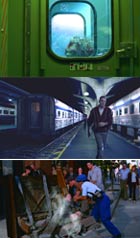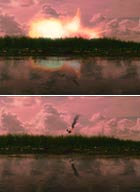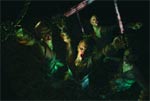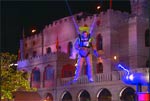If it's the tools that are the key to success when creating special effects for television series, we hope you are attending this month's NAB show. Several post houses interviewed for this story were planning to attend and they are very candid about their wishes (see sidebar on page 66). If it is the talent and their techniques that will unlock the magic formula, better look closely at what you already have, whether your personnel are motivated, inspired, talented.
One post house believes in pushing the envelope, unleashing editors to try different combinations of tools. Another is convinced that one great artist working on high-end equipment is the answer. Many are wrestling with the implications brought on by the high definition format.
SHOWTIME'S DEAD LIKE ME
MGM hired freelance visual effects supervisor Bob Habros for Showtime's Dead Like Me series, which will premiere in July. Much of the post production of the visual effects for the 13-part one-hour series is being done at Rainmaker (www.ainmaker.com), who did the pilot, and Image Engine (www.image-engine.com), who worked on the graveling characters (entities that put things in motion which actually cause death). Both studios are in Los Angeles. The irreverent show, full of black humor, focuses on people literally caught between life and death. There will be about 40 to 50 effects shots per episode.

For Showtimes's Dead Like Me, Rainmaker uses Inferno and LightWave on some of the signature effects.
|
Signature special effects shots are the "pass throughs," when the living go to undead and then take a spirit form. The interactions between these grim reapers and the living often produces sparks of energy or trails of smoke. Discreet's Inferno is used for the signature effects with 3D shots and elements, created and animated in LightWave. Smoke elements are used for more organic effects. Other effects include a CG train wreck, 3D frogs and an amusement park heaven. The show is delivered in HD, though the artists work in NTSC proxy for speed and to nail down the details.
"It's hard to find freelance hired by production nowadays," says Habros. "MGM likes the idea of putting the supervisor on staff with production. Then you have someone representing the interests of the company as they try to get the shots done. When you hire a facility that's all you have. What I can do is go around to the usual or newer places in town, check things out, find out where the artists are. It's a very personal approach that I take - I can take a particular shot to a particular artist wherever they are."
ALIAS HD SHOTS
Digital Dimension (www.digitaldimension.com) in Burbank has worked on three episodes of ABC's Alias, including the special episode that aired after this year's Super Bowl in January. They did about 20 HD shots. The studio's specialty is photoreal CG elements integration into live action film plates.
"The fact that the show is all done in HD makes the entire visual effects production a lot more challenging than regular D-1 productions," says visual effects supervisor Ben Girard. "The additional resolution required for HD slows the development required to get the shots done in a very short period of time, sometimes as low as three days. It's basically the same technical requirements that film needs but with a broadcast schedule. The visual effects studio needs to have a very efficient pipeline and highly knowledgeable staff to pull it off. Alias's visual effects supervisor, Kevin Blank, constantly comes back to us to break the limit of what is possible. One interesting fact is that every single visual effects shot done for the Super Bowl episode was conceived, shot and post produced all within three weeks."
Digital Dimension uses Eyeon's Digital Fusion, Discreet's 3DS Max and Chaos Group's Vray, all running on Dell dual 2.8 GHz Xeons with 2GB RAM.

Digital Dimension has used Digital Fusion, 3DS Max and Vray to create effects in HD for ABC's Alias.
|
ZOIC ATTRACTS A CROWD
Zoic in Los Angeles (www.zoic.com) opened its doors in July 2002. Already it has a large number of visual effects contracts in television, doing work that includes UPN's Twilight Zone, ABC's Miracles, Steven Bochco's NYPD2069 pilot for Fox and WB's Buffy The Vampire Slayer. Interestingly, the post house initially planned to concentrate on effects for advertising, but series work just kept coming in and now accounts for 50 percent of its business. Of that work, 20 percent is HD, but as pilot season approaches that will rise to 70 percent.
For this season's Firefly pilot, which aired in December, Zoic won the very first VES (Visual Effects Society) award for "Best Effects in a Television Series." Creative director Loni Peristere thinks that was due in part to Zoic's technique of rendering all hard surface models in NewTek LightWave, producing photoreal objects in space. The facility plans to do something similar for this season's series finale of Buffy, which will air during May sweeps. Using The Beaver Project, a software that takes a scene created in Alias|Wavefront Maya and renders it in LightWave, Zoic artists have created a cave environment filled with thousands of vampires, the hellmouth under Sunnydale.

Asylum created this plane crash for the premiere of CSI: Miami using Maya, Houdini and Inferno.
|
"We're very excited about this. I think this is going to get us closer to a Lord of the Rings-style for TV," says Peristere. "When you're working with senior level talent that understand Maya where you can script in the package, it allows you to do things like write your own crowd simulators. We decided we were going to need this for the season finale and Andrew Orloff, our CG supervisor, has written a pretty powerful crowd duplication tool that incorporates motion capture data working with flocking locators on alterable terrain for any number of CG extras you might require. Maya's new toolset lets you can pick a square, decide how big that square is, decide how many digital people you want in that square, decide how randomly you want their movements and tell them where to go. It brings together a bound model, motion capture data and Maya's powerful character set-ups. You can also exchange whether those are sprites or full rez people. In that shot we started with a close-up and ended up with over 50,000 folks."
Zoic animators have created visual effects for the entire seven-year run of Buffy, first while at Digital Magic, then POP (which became Riot), then Radium and finally Zoic.The average episode has 18 to 50 visual effects shots, about 10 percent of the total. The two standard effects are morphing humans into vampires and dustings, or what happens when Buffy stakes a vampire. For those, Maya V.4.5 is used with The Kolektive's Stroika, which lets the artists take image maps/photographs and emit particles of the same color and lighting.
ASYLUM VISITS CSI: MIAMI
At Asylum (www.asylumfx.com) in Los Angeles, owner/visual effects director Nathan McGuinness is quite clear on the best way to create special effects for television series: Maintain the same level of quality as that of his feature film and commercial projects. He's not kidding. He opened shop four years ago and methodically analyzed his competition and made improvements, first in music videos, then commercials and films (including Moulin Rouge and Pearl Harbor) and, finally, this season's Jerry Bruckheimer-produced television series CSI: Miami to prove his point.

For Buffy, Zoic created thousands of digital people, sprites and full rez characters thanks to The Beaver Project, Maya and LightWave.
|
Asylum created special effects for seven CSI: Miami episodes, about 50 effects shots per one-hour show, as well as the opening title sequence. One of their first effects jobs was to create a plane crash for which they built a full CGI Lear jet and manufactured the crash. They used a combination of Side Effects Houdini and Maya for CG, Discreet's Inferno for compositing -- all in HD. McGuinness swears by Houdini, the "master of in-your-face-effects," he says.
"Everybody's got to realize that to maintain quality is to maintain the quality of the products as well. I think people could be making mistakes by looking for alternatives that are cheaper," says McGuinness. "The reason we were able to get through it on a television budget level was the skill level of the artist. If a TV series doesn't have the budget and you get a cheap machine, you might get a cheap artist, too, so the job takes 20 times as long and it's costing you more money in the long term. But, if you have an A-grade guy with a boatload of experience who can knock through a shot in a day as opposed to 10 days, who's saving money now? And you're getting a better product. It's the power of 10 scenario - one good man compensates for cheap machinery and the number of workers on it."
Point made, Asylum has currently moved back to film and spot work, including Peter Weir's new movie Master and Commander: The Far Side of the World and several Chevy Tahoe commercials.
"We did our bit," says McGuinness. "We went in there to make sure what Jerry Bruckheimer did for the first time was to the standard. I don't want to engulf my facility in ongoing work. All I'm trying to do is lift the bar. I can't turn my facility into one that is doing episodics but I can definitely do episodics, and just show people out there that there is a quality level we have to maintain and not an attitude of 'there's no budget and you go to a cheap facility.' You can still go to an expensive facility and get the right job done fast. There is no reason to have an attitude any different than commercials and features. You've got to be in all domains."
BELIEVE IT OR NOT: 2,000 FX FOR ONE EPISODE
AlphaDogs (www.alphadogs.tv) in LA works primarily in television post and relies on its people, hence the name.

Alpha Dogs added some effects, with Sapphire, to this human lightning rod for Ripley's Believe it or Not.
|
"The reason we created [AlphaDogs] was equipment prices were dropping considerably and [big] post houses aren't necessarily going to last," says Terry Curren, president and special effects editor.
The studio creates special effects for the TBS series Ripley's Believe it or Not. The average 45-minute show has over 2,000 effects, nearly everything is effected, from film-look plug-ins to various transitions. One artist even uses Avid's simple title tool to create layers of digital readouts, then uses it to draw little objects in the eyes, all to make old material look new again. They've done this for four seasons. Ripley's source material is archival, PAL transfer, VHS, poorly shot DV and more. The first level of effects is color correction and fixing; then the show is highly styled. GenArts Sapphire extensions, with their new plug-ins, Boris Continuum, are used a lot. Curren puts it together in the Avid Symphony.
"The good news is they can do a lot of the comping with layers of effects and plug-ins in the offline, and everything matches," explains Curren. "In those kinds of situations, I just tweak. In other situations I actually have to build from the ground up. Sometimes I sub things out to our graphics dept where they work with Commotion, Combustion and After Effects."
Curren used Sapphire for a man who has lightning arc off his body. "They needed a shot from a certain angle and there weren't any so I took the guy from one shot and the actual device from another shot, comped the two together, used the lightning plug-in to create lightning coming off his hands so it blends in with rest of the shoot," says Curren.
Alpha Dogs has not yet jumped to HD. "I think it's getting closer but it's not going to be what everyone expects it to be," he says. "I know that's what the big post houses think is going to save them, but if you can buy the JVC camera [GR-HD1 hi-def digital video] and FireWire B is able to bring that in as a stream, you don't need a card, you just have more drives, and that's pretty hard to compete with."
AT ENCORE, TREMORS AND MORE
Encore Hollywood (www.encorevideo. com) tackles special effects for 10 shows in-house at a time. The newest one is Tremors, which premiered on the Sci-Fi Network in March. The one-hour show is a takeoff of the popular film series, featuring real puppets on set intermingled with much 3D CG. In it, monsters come out of the ground and attack things.
Their VFX artists use 3DS Max 5.1 with Digital Fusion, turning the practical puppets into CG characters so they can do things like burst out of the ground, eat motorcycles and drag their riders back underground. Inferno is used for compositing. There are five CG artists and four Mac artists on After Effects creating dust enhancements. Their hardware is dual Pentium Xeon 2.8 GHz processors with 2GB of RAM.
"The hard part is trying to make these characters have a life of their own, as well as a personality, because they're recurring characters. There are also guest creatures in different episodes, which is also a challenge under the time constraints," says director of visual effects Barbara Marshall. "We had a month to do 3D and puppets in the first episode, but now we're down to one and a half weeks per episode."